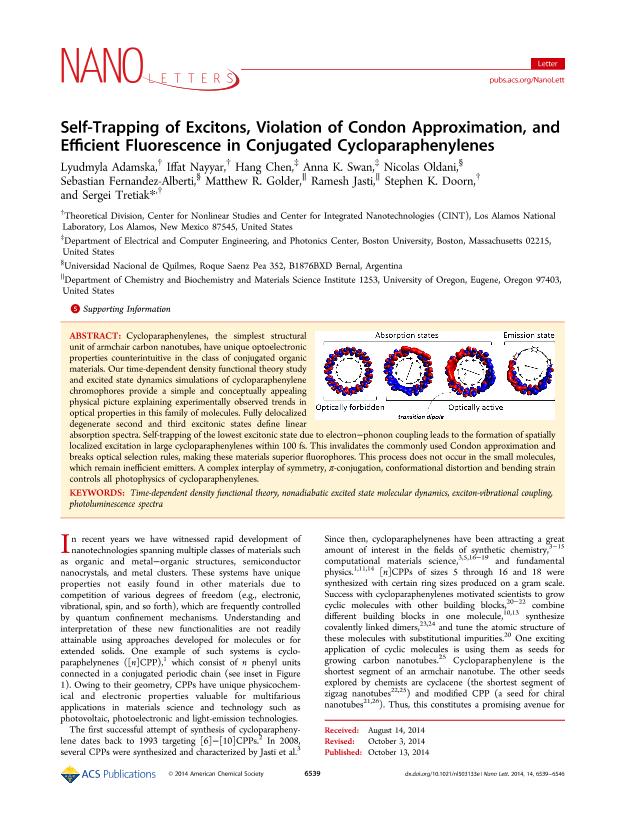Artículo
Self-trapping of excitons, violation of condon approximation, and efficient fluorescence in conjugated cycloparaphenylenes
Adamska, Lyudmyla; Nayyar, Iffat; Chen, Hang; Swan, Anna K.; Oldani, Andres Nicolas ; Fernández Alberti, Sebastián
; Fernández Alberti, Sebastián ; Golder, Matthew R.; Jasti, Ramesh; Doorn, Stephen K.; Tretiak, Sergei
; Golder, Matthew R.; Jasti, Ramesh; Doorn, Stephen K.; Tretiak, Sergei
 ; Fernández Alberti, Sebastián
; Fernández Alberti, Sebastián ; Golder, Matthew R.; Jasti, Ramesh; Doorn, Stephen K.; Tretiak, Sergei
; Golder, Matthew R.; Jasti, Ramesh; Doorn, Stephen K.; Tretiak, Sergei
Fecha de publicación:
11/2014
Editorial:
American Chemical Society
Revista:
Nano Letters
ISSN:
1530-6984
Idioma:
Inglés
Tipo de recurso:
Artículo publicado
Clasificación temática:
Resumen
Cycloparaphenylenes, the simplest structural unit of armchair carbon nanotubes, have unique optoelectronic properties counterintuitive in the class of conjugated organic materials. Our time-dependent density functional theory study and excited state dynamics simulations of cycloparaphenylene chromophores provide a simple and conceptually appealing physical picture explaining experimentally observed trends in optical properties in this family of molecules. Fully delocalized degenerate second and third excitonic states define linear absorption spectra. Self-trapping of the lowest excitonic state due to electron-phonon coupling leads to the formation of spatially localized excitation in large cycloparaphenylenes within 100 fs. This invalidates the commonly used Condon approximation and breaks optical selection rules, making these materials superior fluorophores. This process does not occur in the small molecules, which remain inefficient emitters. A complex interplay of symmetry, π-conjugation, conformational distortion and bending strain controls all photophysics of cycloparaphenylenes.
Archivos asociados
Licencia
Identificadores
Colecciones
Articulos(SEDE CENTRAL)
Articulos de SEDE CENTRAL
Articulos de SEDE CENTRAL
Citación
Adamska, Lyudmyla; Nayyar, Iffat; Chen, Hang; Swan, Anna K.; Oldani, Andres Nicolas; et al.; Self-trapping of excitons, violation of condon approximation, and efficient fluorescence in conjugated cycloparaphenylenes; American Chemical Society; Nano Letters; 14; 11; 11-2014; 6539-6546
Compartir
Altmétricas



